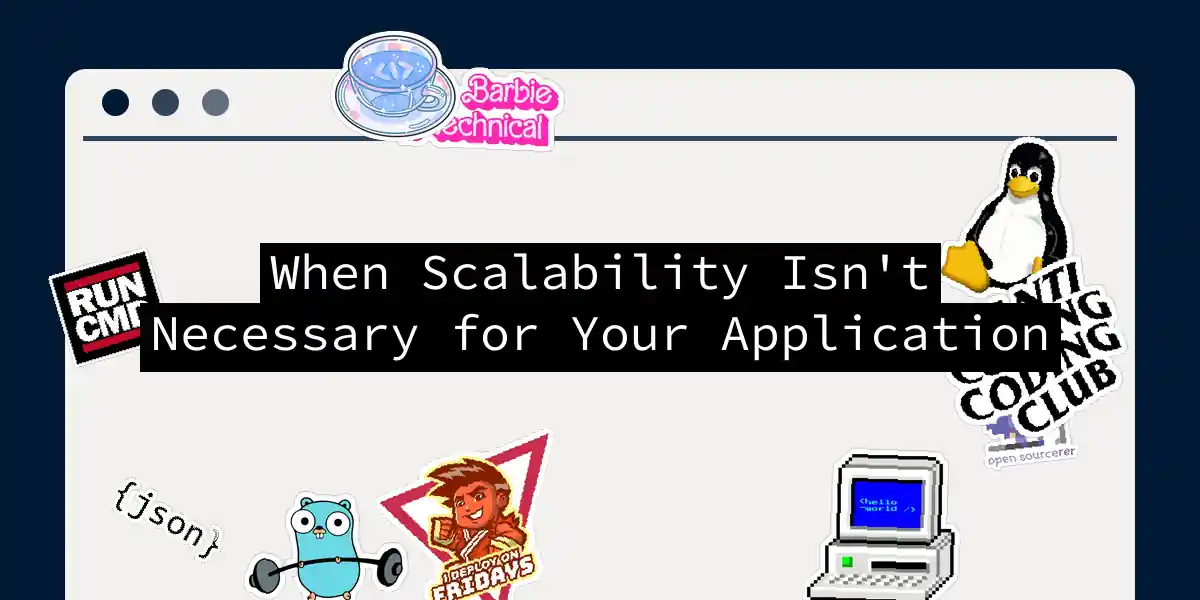The Scalability Conundrum: Not Every App Needs to Be a Giant
In the world of software development, scalability is often touted as the holy grail. We’re constantly reminded that our applications need to be ready to handle millions of users, scale horizontally, and perform flawlessly under any load. But what if your app doesn’t need to be the next Facebook or Netflix? What if it’s just a simple tool designed for a small, niche audience?
Understanding Scalability
Before we dive into why scalability might not be necessary for every application, let’s quickly define what scalability is. Scalability refers to the ability of an application to handle increased load and demand without compromising performance, speed, or reliability. This can be achieved through either horizontal scaling (adding more servers) or vertical scaling (increasing the power of existing servers)[1].
The Cost of Scalability
Scalability comes with a price tag. Building an application that can scale to millions of users requires significant investment in infrastructure, architecture, and maintenance. Tech giants like Google and Amazon can afford this, but what about a small business or a solo developer?
For instance, if you’re building a calendar app for personal use or a local business, you don’t need to worry about handling a million concurrent users. Your app might never see more than a few hundred users at any given time. In such cases, the complexity and cost associated with scalability are simply not justified.
Identifying When Scalability Isn’t Necessary
So, how do you determine if your application needs scalability? Here are a few key factors to consider:
Expected User Growth
If your app is designed for a small, stable user base, scalability might not be a priority. For example, a local salon’s appointment booking system or a personal finance tracker for a small group of users.
Peak Usage
If your app experiences peak usage only during specific times (like a holiday season for an e-commerce site), you might be able to handle these spikes with temporary scaling solutions rather than a full-scale scalable architecture.
Downtime Tolerance
If your users can tolerate occasional downtime or slower performance, the need for high scalability diminishes. This is often the case with internal tools or apps that are not customer-facing.
Examples of Apps That Don’t Need Scalability
Calendar and Notes Apps
A personal calendar or notes app on your phone does not require a robust scalability plan. These apps are designed for individual use and rarely see concurrent access from multiple users[1].
Local Business Tools
A small business might use an app for managing inventory or scheduling appointments. These apps typically have a fixed and small user base, making scalability less of a concern.
Internal Tools
Many internal tools within companies, such as project management dashboards or HR portals, do not need to scale to handle millions of users. They are designed for a specific, limited audience.
Architectural Considerations
When you decide that scalability isn’t necessary, your architectural choices can be significantly simplified. Here are a few considerations:
Monolithic Architecture
For small-scale apps, a monolithic architecture can be more than sufficient. This approach is simpler to develop and maintain compared to microservices, which are often used in scalable applications.
Simplified Tech Stack
You can choose a simpler tech stack that doesn’t require the complexity of cloud services or containerization. For example, using a single server with a straightforward database setup can be enough.
No-Code Platforms and Scalability
No-code platforms have made it easier for non-technical users to build applications, but even here, scalability is not always a must. However, some no-code platforms are designed with scalability in mind, which can be beneficial if your app unexpectedly grows.
For instance, platforms like Xano, Backendless, and Supabase offer scalable backends that can handle increased traffic, but you might not need these features if your app is small-scale[2].
Conclusion
Scalability is a powerful tool, but it’s not a one-size-fits-all solution. Understanding your application’s needs and user base is crucial in determining whether scalability is necessary. By focusing on simplicity and cost-effectiveness, you can build efficient and reliable applications that meet your specific requirements without the overhead of scalability.
So, the next time you’re designing an app, remember that sometimes less is more. Don’t scale just for the sake of scaling; scale because it makes sense for your users and your business.
And as the old saying goes, “Don’t use a sledgehammer to crack a nut.” Unless, of course, you’re building an app for a giant nut-cracking industry – in which case, go ahead and scale away
